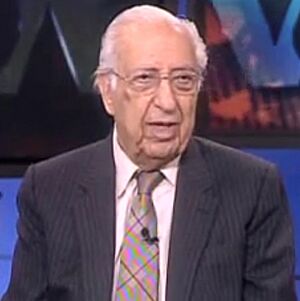Hooshang Seyhoun facts for kids
Quick facts for kids
Houshang Seyhoun
|
|
|---|---|
| هوشنگ سیحون | |
 |
|
| Born |
Houshang Seyhoun
August 22, 1920 |
| Died | May 26, 2014 (aged 93) |
| Nationality | Iranian |
| Citizenship | Iran Canada France |
| Alma mater | University of Tehran École nationale supérieure des Beaux-Arts |
| Occupation | Architect, sculptor, painter |
| Spouse(s) |
Massoumeh Seyhoun
(m. 1950; div. 1973) |
| Children | 2 |
| Design | Tomb of Ferdowsi Mausoleum of Omar Khayyám Avicenna Mausoleum Tomb of Nader Shah |
Houshang Seyhoun (born August 22, 1920, died May 26, 2014) was a very talented Iranian architect, sculptor, painter, and professor. He was known for his creative and new ideas in architecture.
He studied art at the École nationale supérieure des Beaux-Arts in Paris, France. He also earned a degree in architecture from the University of Tehran in Iran.
Seyhoun became famous in the 1950s for his designs. These included Tehran's Central Railway Station and tombs for important thinkers. One famous tomb he designed was the Avicenna Mausoleum in Hamadan. He taught at Tehran University's College of Architecture. He also led the College of Fine Arts there for six years.
Contents
Early Life and Education
Houshang Seyhoun was born into a family famous for music. His grandfather, Mirza Abdollah Farahani, was a pioneer in traditional Iranian music. He is known as the father of traditional music in Iran. Seyhoun's mother, Mowloud Khanom, played the Setar, a musical instrument. His uncle, Ahmad Ebadi, was a master Setar player.
Houshang Seyhoun started his studies at the College of Art and Architecture. He learned from teachers like Andre Godard and Maxime Siroux. Seyhoun chose to study in Siroux's studio. He liked that Siroux cared deeply about Iran.
Studying in Paris
After finishing his studies at Tehran University, Seyhoun went to Paris. Andre Godard invited him to continue his education there. Seyhoun was already well-known for winning design competitions. He had designed mausoleums for famous figures like Ferdowsi and Ebne Sina.
He finished his training at the Ecole des Beaux-Arts in 1948. His final project was "The Mausoleum of Avicenna in Hamadan." After three years of study, he earned his Ph.D. in art. When he returned to Iran, he created his first major work. It was a memorial monument for Abu-Ali Sina, which he designed at age 23.
Career and Contributions
Seyhoun became the dean of the School of Fine Arts at the University of Tehran in 1961. He took over from Mohsen Foroughi. As dean, Seyhoun changed the school's courses. He added lessons on Iranian historical architecture.
He took his students to explore different buildings across Iran. Their work with the antiquities department helped many old buildings become recognized as historic sites.
Designing Famous Monuments
Seyhoun also designed monuments for important Iranian poets and thinkers. One of his most famous designs is the Tomb of Omar Khayyam. He was part of several important committees. These included The National Committee of Archeology. He also helped with repairing historical buildings in Iran for 15 years.
Seyhoun believed that a good architect should be simple and clear, like a poet.
His body was buried in Los Angeles, wrapped in the Iranian flag. In his will, he asked for all his paintings and drawings to be given to a museum in Iran.
Notable Works
Seyhoun's work includes several important monuments. These are:

